


In the Pathways research programme, the analysis of future developments in the European energy systems starts with a detailed description of the existing energy system. Each research group has been involved in creating databases regarding the present situation (in some cases also including historical developments and near-term plans). These databases have incorporated information obtained from different sources, including in-depth interviews, data and literature surveys, available statistics, and direct contacts with, for example, energy utility companies, energy plant owners, and international and national energy agencies. Also included is information from external databases that has been derived from official national and European statistics, EU-funded projects, research institutes, and private companies.
Four such sub-databases are included in the Chalmers Energy Infrastructure database (CEI db). The CEI db describes different parts and areas of the European energy system, both on the demand side and the supply side (Figure I). Currently, the main sub-databases are: the Chalmers Power Plant database; the Chalmers Fuel database; the Chalmers Industry database; and the Chalmers CO2 Storage database. The CEI db is being updated on a continuous basis and its scope is gradually being extended. The key features of these different databases are summarised in the textbox on the next page. Moreover, the Fuel database and Power Plant database are presented in greater detail below.
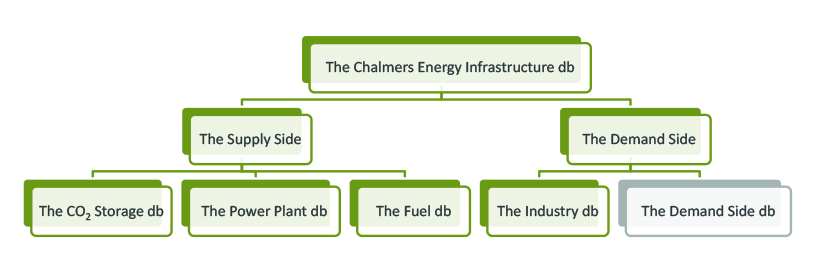
Figure I: Structure of the Chalmers Energy Infrastructure database. The databases marked in green are ready to use, while the one marked in grey is under construction.
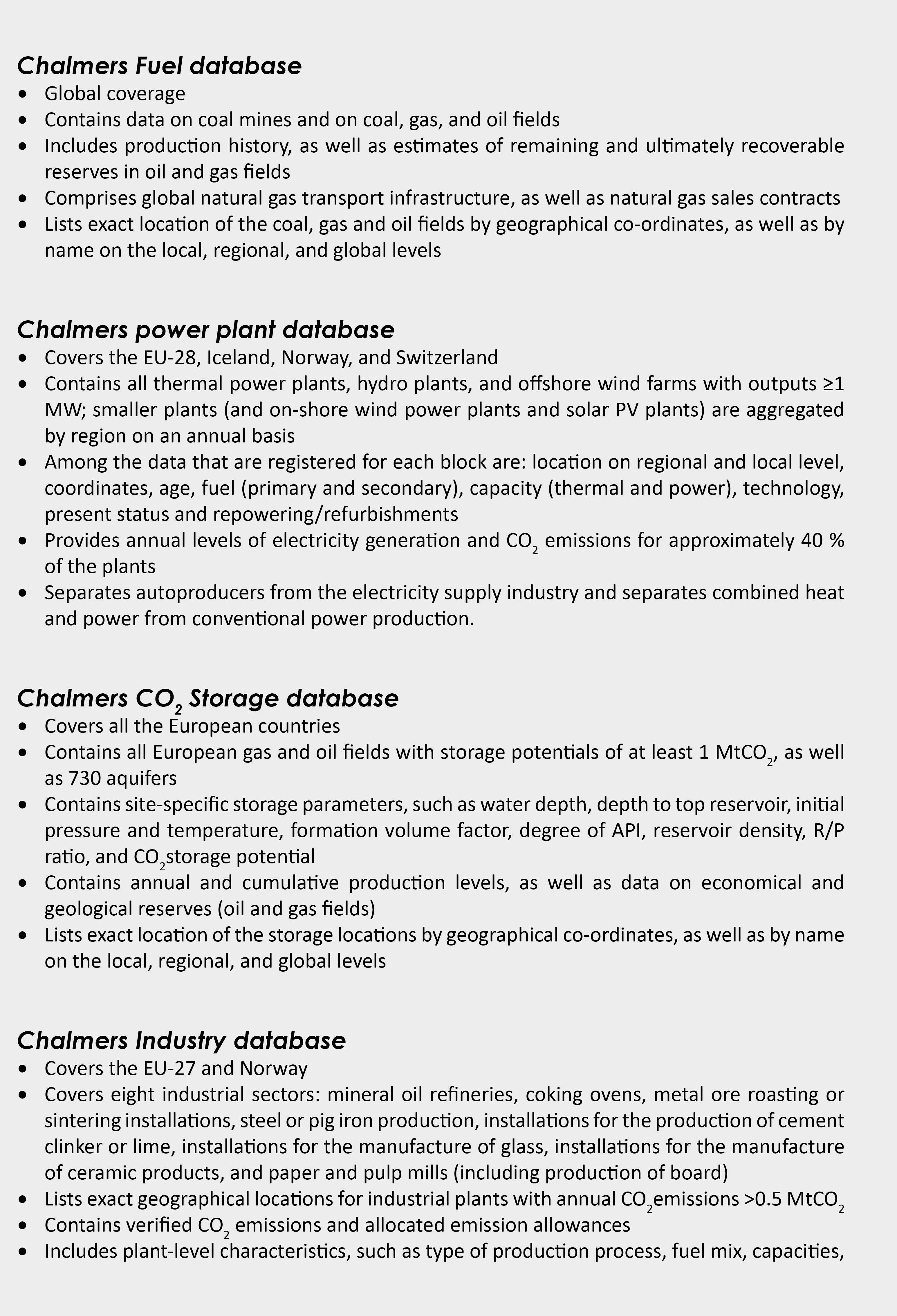
The Chalmers Fuel database is an umbrella term for the Chalmers Oil, Gas and Coal databases, which have been used as a solid basis for formulating realistic near-term scenarios for development of the energy system. The three databases have global coverage and its primary objective has been to track current and future capacities of transport infrastructure, contracted transport flows and future global production capacities. The databases contain the exact locations listed by geographical coordinates, as well as by name on local, regional and global levels. Figure 2 shows all oil and gas fields registered in the database as of January 1st, 2016.
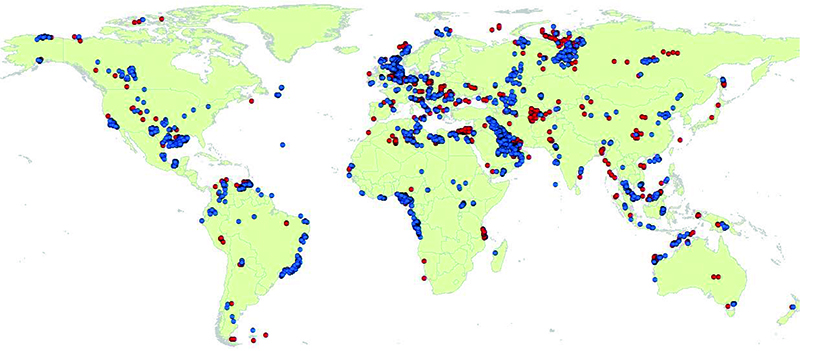
Figure II: Oil and gas fields (blue and red circles respectively) in Chalmers oil and gas field database as of January 1st, 2016.
The Chalmers Power Plant database contains all power plants including wind farms and solar plants (PV + thermal) in EU28, Iceland, Norway and Switzerland with a production capac i ty greater than 1 MW; smaller plants are aggregated by national regions on an annual basis, i.e. the year of commissioning is accurately registered in the database. In the database there is data of the plants exact location, age, fuel, thermal and power generation capacity, technology, present status, type of producer (auto-producer, condense only, CHP), scrubbers and repowering. The location of the power plants is further categorized into local, regional and national areas allowing for readily access for various levels of research. In addition to the previous mentioned stored data, annual electricity generation and CO2emissions are provided for a large part of the power plants. Figure III shows operational capacity for power plants in EU-28 as of December 31st, 2015, distributed by age and fuel/technology.
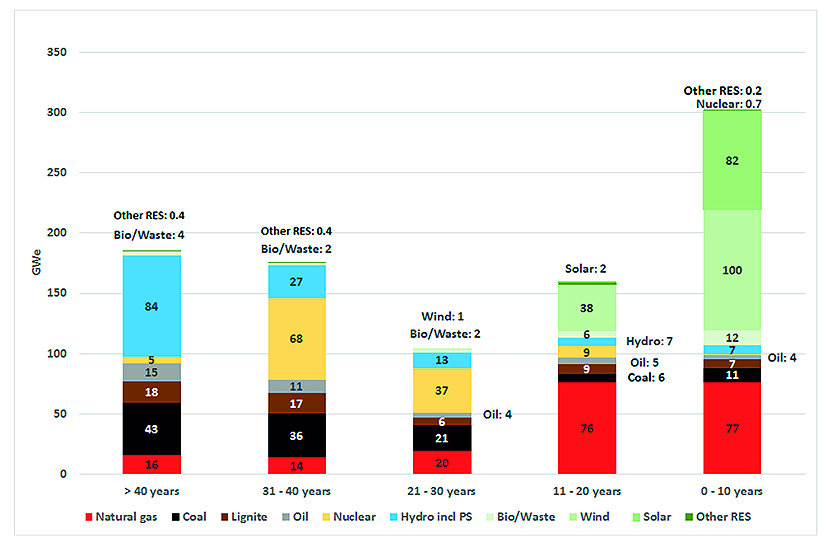
Figure III: Operational power plant capacity (GWe) distributed by age and fuel/technology in EU-28 as of January 1st, 2016.
The Chalmers Oil database is edified of three sub databases: The Oil Field database (OF db), the Oil Field Project database (OFP db), and a database containing statistical data for 55 international and national Oil Companies (OC db). The three sub databases are continuously updated.
The OF db includes around 3,300 oil fields worldwide including all giant fields registered by the American Association of Petroleum Geologists (AAPG) up to 2011. Giant fields discovered after 2010 are of course also included in the database. For each field, historical and current production and reserve and u ltimate resource data have been registered and updated if available in the public domain, e.g. through data contained in the International Energy Agency’s 2005 and 2008 editions of the World Energy Outlook. The data contained in the OF db accounts for roughly 60% of the global oil production and reserves (as of January 1st, 2016). The OF db contains in addition to production and reserves data, parameters that enables categorization by region, specific location (onshore, offshore, shallow-water, deep-water, and ultra-deep-water), and size.
The OFP db tracks major oil projects worldwide with regard to location, production capacity, estimated reserves and ultimate recovery, start-up year and developers.
The statistical data in the OC db covers production, reserves, resources, reserve replacement, acreage (developed, undeveloped, and regional location), and wells (exploratory, under development, and production).
The Chalmers Gas database is a collection of three continuously updated sub databases: The Gas Field database (GF db), the Gas Infrastructure database (GI db), and the Gas Sales and Purchase Agreement database (GSPA db).
The GF db contains information on more than 2,600 gas field worldwide, accounting for around 60% of global reserves. All dis covered giant fields by January 1st , 2016, are i nc luded i n the databas e. The gas fields are classified according to size and location, and contains annual production history and reserve and resource data if the data exists in the public domain.
The GI db provides global coverage of all Liquefied Natural Gas (LNG) plants and re-gasification terminals and includes information on capacity, current status, and exact location. In addition to LN G plants a nd reg as i fi c ati o n t erm i na ls , the database contains capacity, properties and route for transboundary gas pipelines. Moreover, it also includes the bulk of European gas storage sites registered with withdrawal and injection capacities, and working gas and cushion gas levels.
The GSPA db contains information of global gas sales and purchase agreements for LNG and pipelines. The database includes information on contracted quantity, take or pay quantity and if the contract is linked to the oil price. The database also contains start-up and expiring date of the contract. Singling out buyers in the EU, the GSPA db contains LNG and pipe contracts for annual supply of 150 bcm and 400 bcm respectively, including contracts covering present or future supply.
Figure 3 shows all LNG exporting plants in operation (blue squares) and under construction (yellow squares) as well as operating European regasification terminals (red circles). Thus the Figure does not show small liquefaction plants with capacities usually well below 0.5 Mt LNG per year and used domestically (e.g. there are some 20 such plants in China).
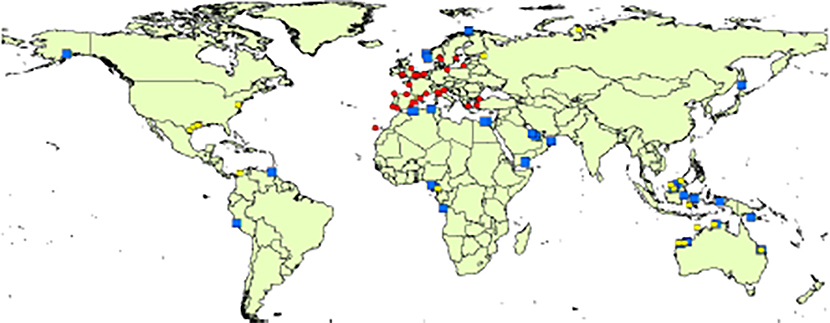
Figure IV: Major LNG export plants in operation (blue squares) and under construction (yellow squares) and European regasification terminals (red circles). Data refer to end of 2015, small LNG plants primarily for domestic use are not shown.
The C02 Storage database (CS db) contains information on potential CO2 storage reservoirs in Europe with a storage potential exceeding 1 MtCO2. Currently there are approximately 1,200 different reservoirs in the database, of which about 600 has a storage potential of 10 MtC02 or more. The total storage potential of all reservoirs in the database is roughly 125 GtCO2. Readers should be aware however that a reservoirs storage potential is highly uncertain and accurate estimates will require drilling which is costly in offshore reservoirs where most of the estimated storage potential is believed to be located. Also the CO2 storage database is continuously being updated for instance with the most recent (accurate) estimates of storage potential.
The Chalmers Coal Database contains three sub databases, the coal field database (CF db), the coal ports database (CP db) and the coal-based power plants database (CPP db).
The coal field database contains data on a global scale with approximately 200 lignite fields and 580 coal fields. The coal ports database is comprised of data from almost 100 coal ports, located in high coal export countries. The third sub database, the coal-based power plant, is comprised of 530 coal plant projects, with a combined power generation capacity of 465 GW. The Chalmers Coal Database and its sub databases was established for a specific analysis and was discontinued at the end of the project, hence the data contained in the database may be out of date.
The Chalmers Industry database contains information on industrial plants with annual C02 emissions exceeding 0.5 MtC02, across eight industrial sectors throughout Europe. The database includes the exact geographic location of the plants, their verified CO2 emissions and allocated emission allowances. Moreover, it includes plant-level characteristics such as type of production process, fuel mix, and age.
Building Stocks is a Dataset on existing buildings in Sweden energy properties, physical and thermal. Included in the dataset are houses existing heating and ventilation system, type of building (single-family or multi-family houses), and climatic conditions.